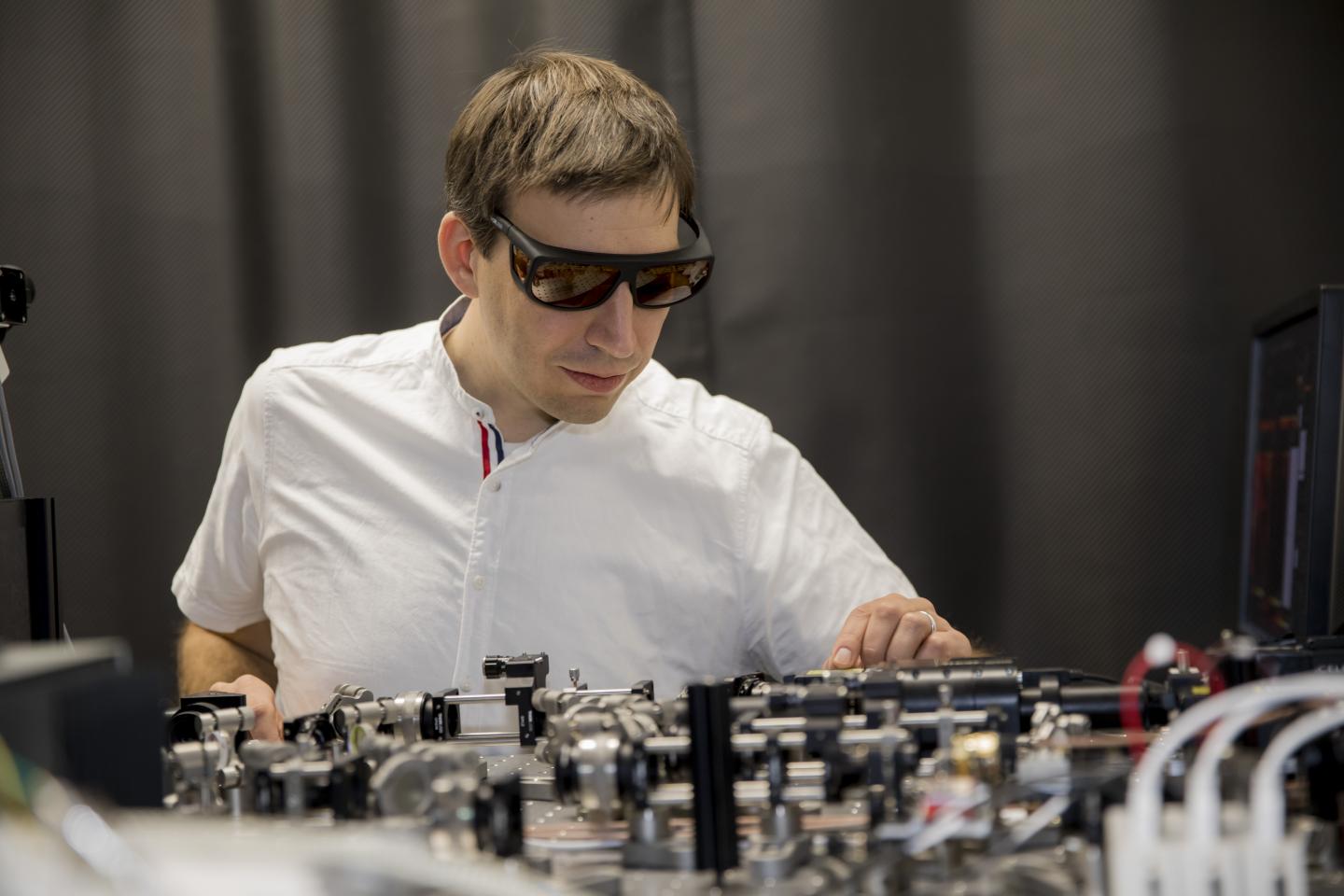
Credit: © Helmholtz Zentrum München/Carolin Jacklin
To visualize processes in living organisms is the goal of Dr. Oliver Bruns and his team at the Helmholtz Pioneer Campus. His work is now being funded by the German Research Foundation (DFG) with an Emmy Noether grant, which will provide 1.5 million euros over the next five years.
Much of the money will flow into the development of SWIR technology. “SWIR stands for short-wave infrared, meaning infrared radiation at wavelengths of over 1000 nanometers,” explains Oliver Bruns, principal investigator of the first Helmholtz Pioneer Campus team, just recruited to Munich in 2018. “That’s precisely the range we use for our imaging approach with fluorescence dyes in contrast to conventional methods, which employ wavelengths of between 700 and 900 nanometers or the visible range.”
Thanks to this technique, the researchers achieve better contrast and sharper images than with current methods, because “light of shorter wavelengths tends to scatter more, making structures appear blurred,” Bruns says. “We avoid this scattering effect and are able to visualize structures inside the body in much greater detail.”
Bruns and his former colleagues at the Massachusetts Institute of Technology (MIT) in Cambridge have already demonstrated how powerful the technique is. In recent publications (e.g. in Nature Biomedical Engineering, Nature Medicine or PNAS) they visualized physiological processes in unprecedented detail.
Concept proved – sights set on practical applications
“In fact, we were able to work out many fundamental aspects of the technology and lay the foundations for further development at MIT. The application for Emmy Noether funding was also along those lines,” Oliver Bruns explains. “Backed by this funding, we now aim to bring SWIR imaging to the next level and put it into the hands of biologists and clinicians at the Helmholtz Pioneer Campus.”
Many scientists are eager to look over his shoulder. Three professors from the United States – Prof. Ellen Sletten (UCLA), Prof. Ou Chen (Brown University) and Prof. Tulio Valdez (Stanford University) – have been named as Mercator fellows and are invited to join the Pioneer Campus to work with his group. This is a prestigious exchange program funded by the German Research Foundation (DFG) supporting the Emmy Noether proposal of Oliver Bruns.
“In this context, Tulio Valdez and Maly Cosco from the group of Ellen Sletten were working as guests in our laboratory,” Oliver Bruns says. “The exchange with them and other colleagues is the creative driving force behind our research and shows that our work has attracted considerable international attention.”
###
Further Information
Find out more about Oliver Bruns and his work in the article “Zooming in on the essentials of life!”: https:/
Background:
The Emmy Noether Programme gives exceptionally qualified early career researchers the chance to qualify for the post of professor at a university by leading an independent junior research group for a period of six years. http://www.
The Helmholtz Zentrum München, the German Research Center for Environmental Health, pursues the goal of developing personalized medical approaches for the prevention and therapy of major common diseases such as diabetes, allergies and lung diseases. To achieve this, it investigates the interaction of genetics, environmental factors and lifestyle. The Helmholtz Zentrum München is headquartered in Neuherberg in the north of Munich and has about 2,300 staff members. It is a member of the Helmholtz Association, a community of 19 scientific-technical and medical-biological research centers with a total of about 37,000 staff members. http://www.
Helmholtz Pioneer Campus (HPC) stands for the intelligent fusion of biomedicine, engineering and digitization. Top scientists from all over the world work together to develop novel tools and solutions for the prevention, diagnosis and treatment of urgent medical needs. The aim of HPC is to establish a highly dynamic research environment at the interface of various disciplines – one that is free from the continuous pressure of having to apply for third-party funding and with minimum administrative work. Founded by and embedded in the Helmholtz Zentrum München and as part of the Helmholtz Association, Germany’s largest research organization, HPC offers a place for innovation and start-up culture. HPC derives its name and guiding principles from Hermann von Helmholtz: physician and physicist, mathematician and pioneer of applied science. http://www.
Contact for the media:
Department of Communication, Helmholtz Zentrum München – German Research Center for Environmental Health, Ingolstädter Landstr. 1, 85764 Neuherberg – Tel. +49 89 3187 2238 – E-mail: [email protected]
Scientific Contact:
Dr. Oliver Bruns, Helmholtz Zentrum München – German Research Center for Environmental Health, Helmholtz Pioneer Campus, Ingolstädter Landstr. 1, 85764 Neuherberg – Tel. +49 89 3187 49494 – E-mail: [email protected]
Media Contact
Dr. Oliver Bruns
[email protected]
49-893-187-49494
Original Source
https:/




